High-Strength Building Material Based on a Glass Concrete Binder Obtained by Mechanical Activation
Abstract
1. Introduction
2. Materials and Methods
3. Results
3.1. Study of the Chemical Interaction between Finely Ground Glass and Calcium Oxide
3.2. Composite Material Based on a Glass Concrete Binder
- (1)
- In natural conditions (at a temperature of 40 ± 3 °C and a relative air humidity of 95 ± 5%) within 24 h;
- (2)
- Steaming samples at a temperature of 100 °C and a humidity of 100%.
- −
- Short—1 and 4 h;
- −
- Normal—8 h;
- −
- Extended—16 h.
Compressive Strength
4. Conclusions
Author Contributions
Funding
Informed Consent Statement
Data Availability Statement
Acknowledgments
Conflicts of Interest
References
- Resource Recovery from Wastes: Towards a Circular Economy (ISSN), 1st ed.; Macaskie, L.E., Sapsford, D.J., Mayes, W.M., Eds.; Royal Society of Chemistry: London, UK, 2019; ISBN 978-1788013819. [Google Scholar]
- Zhang, Z.; Malik, M.Z.; Khan, A.; Ali, N.; Malik, S.; Bilal, M. Environmental impacts of hazardous waste, and management strategies to reconcile circular economy and eco-sustainability. Sci. Total Environ. 2022, 807, 150856. [Google Scholar] [CrossRef] [PubMed]
- Wang, B.; Ren, C.; Dong, X.; Zhang, B.; Wang, Z. Determinants shaping willingness towards on-line recycling behaviour: An empirical study of household e-waste recycling in China. Resour. Conserv. Recycl. 2019, 143, 218–225. [Google Scholar] [CrossRef]
- Ho, L.S.; Huynh, T.-P. Recycled waste medical glass as a fine aggregate replacement in low environmental impact concrete: Effects on long-term strength and durability performance. J. Clean. Prod. 2022, 368, 133144. [Google Scholar] [CrossRef]
- Wang, L.P.; Tseng, P.W.; Huang, K.J.; Chen, Y.J. Foam glass production from waste bottle glass using silicon cutting waste of loose abrasive slurry sawing as foaming agent. Constr. Build. Mater. 2023, 383, 131344. [Google Scholar] [CrossRef]
- Harrison, E.; Berenjian, A.; Seifan, M. Recycling of waste glass as aggregate in cement-based materials. Environ. Sci. Ecotechnol. 2020, 4, 100064. [Google Scholar] [CrossRef] [PubMed]
- Fakhratov, M.A. Effektivnaya tekhnologiya ispolzovaniya promyshlennykh otkhodov v proizvodstve betona i zhelezobetona. Stroit. Mater. 2003, 12, 48–49. [Google Scholar]
- Shen, W.; Zhou, M.; Zhao, Q. Study on lime–fly ash–phosphogypsum binder. Constr. Build. Mater. 2007, 21, 1480–1485. [Google Scholar] [CrossRef]
- Jiang, X.; Xiao, R.; Bai, Y.; Huang, B.; Ma, Y. Influence of waste glass powder as a supplementary cementitious material (SCM) on physical and mechanical properties of cement paste under high temperatures. J. Clean. Prod. 2022, 340, 130778. [Google Scholar] [CrossRef]
- Bansal, N.P.; Doremus, R. Handbook of Glass Properties; Elsevier: Amsterdam, The Netherlands, 2013. [Google Scholar]
- Taylor, J.; Dinsdale, A. Thermodynamic and phase diagram data for the CaO-SiO2 system. Calphad 1990, 14, 71–88. [Google Scholar] [CrossRef]
- Ahmed, H.U.; Mohammed, A.A.; Mohammed, A.S. Effectiveness of Silicon Dioxide Nanoparticles (Nano SiO2) on the Internal Structures, Electrical Conductivity, and Elevated Temperature Behaviors of Geopolymer Concrete Composites. J. Inorg. Organomet. Polym. 2023. [Google Scholar] [CrossRef]
- Jani, Y.; Hogland, W. Waste glass in the production of cement and concrete-A review. J. Environ. Chem. Eng. 2014, 2, 1767–1775. [Google Scholar] [CrossRef]
- Shayan, A.; Xu, A. Performance of glass powder as a pozzolanic material in concrete: A field trial on concrete slabs. Cem. Concr. Res. 2006, 36, 457–468. [Google Scholar] [CrossRef]
- Kadhim, A.; Sadique, M.; Al-Mufti, R.; Hashim, K. Developing one-part alkali-activated metakaolin/natural pozzolan binders using lime waste. Adv. Cem. Res. 2021, 33, 342–356. [Google Scholar] [CrossRef]
- Xiao, R.; Ma, Y.; Jiang, X.; Zhang, M.; Zhang, Y.; Wang, Y.; Huang, B.; He, Q. Strength, microstructure, efflorescence behavior and environmental impacts of waste glass geopolymers cured at ambient temperature. J. Clean. Prod. 2019, 252, 119610. [Google Scholar] [CrossRef]
- Fomina, E.V.; Strokova, V.V.; Kozhukhova, M.I. Effect of Previously Slacked Lime on Properties of Autoclave Composite Binders. World Appl. Sci. J. 2013, 24, 1519–1524. [Google Scholar] [CrossRef]
- Yamadaa, K.; Takahashi, T.; Hanehara, S. Matsuhisa Effects of the chemical structure on the properties of polycarboxylate-type superplasticizer. Cem. Concr. Res. 2000, 30, 197–207. [Google Scholar] [CrossRef]
- Santana-Carrillo, J.; Burciaga-Díaz, O.; Escalante-Garcia, J. Blended limestone-Portland cement binders enhanced by waste glass based and commercial sodium silicate-Effect on properties and CO2 emissions. Cem. Concr. Compos. 2021, 126, 104364. [Google Scholar] [CrossRef]
- Hassan, A.; Mahmud, G.; Mohammed, A.; Jones, S. The influence of normal curing temperature on the compressive strength development and flexural tensile behaviour of UHPFRC with vipulanandan model quantification. Structures 2021, 30, 949–959. [Google Scholar] [CrossRef]
- Barin, I. Thermochemical Data of Pure Substances, 3rd ed.; Barin, I., Ed.; VCH VerlagsgesellschaftmbH: Vancouver, BC, Canada, 1995; p. 1885. [Google Scholar]
- Svatovskaya, L.B.; Sychova, A.M.; Soloviova, V.Y.; Maslennikova, L.L.; Sychov, M.M. SychovAbsorptive Properties of Hydrate Silicate Building Materials and Products for Quality and Geoecoprotection Improvement. Indian J. Sci. Technol. 2016, 9, 104231. [Google Scholar] [CrossRef][Green Version]
- Topas, B.A. V4: General profile and structure analysis software for powder diffraction data. In User’s Manual; Bruker AXS: Karlsruhe, Germany, 2008. [Google Scholar]
- Liao, J.; Qing, G.; Zhao, B. Phase Equilibrium Studies in the CaO–SiO2–Al2O3–MgO System with MgO/CaO Ratio of 0.2. Metall. Mater. Trans. B 2023, 54, 793–806. [Google Scholar] [CrossRef]
- Gorshkov, V.S.; Timashev, V.V.; Savelev, V.G.; Gorshkov, V.S. Methods of Physical and Chemical Analysis of Binders Tutorial; M. High School: Moskov, Russia, 1981; p. 335. [Google Scholar]
- Bakhtina, T.A.; Lyubomirskiy, N.V.; Bakhtin, A.S.; Yaroshenko, A.A. Building Materials Based on Dolomite Binding Carbonate Hardening. Construction and Technogenic Safety. 2019. No. 16 (68). Available online: https://cyberleninka.ru/article/n/stroitelnye-materialy-na-osnove-dolomitovogo-vyazhuschego-karbonatnogo-tverdeniya (accessed on 23 July 2023).
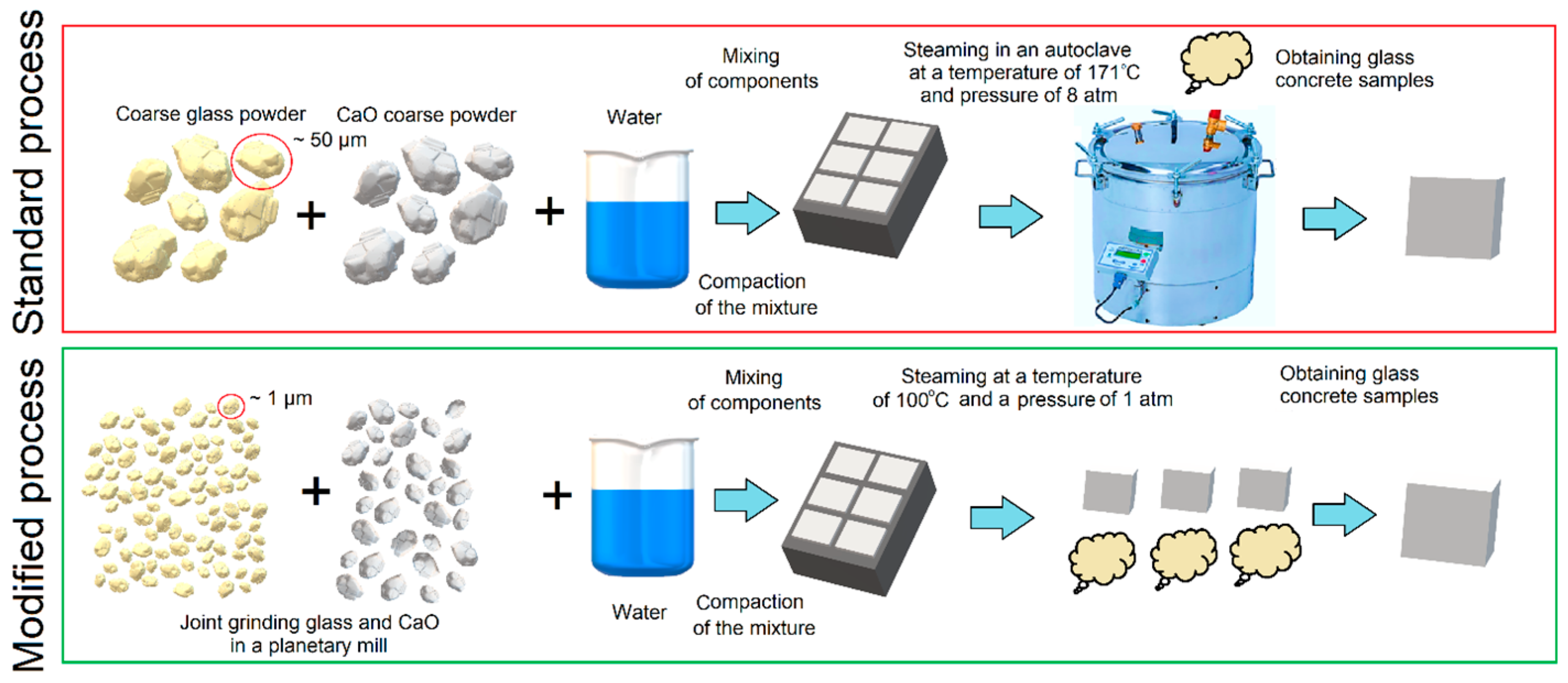
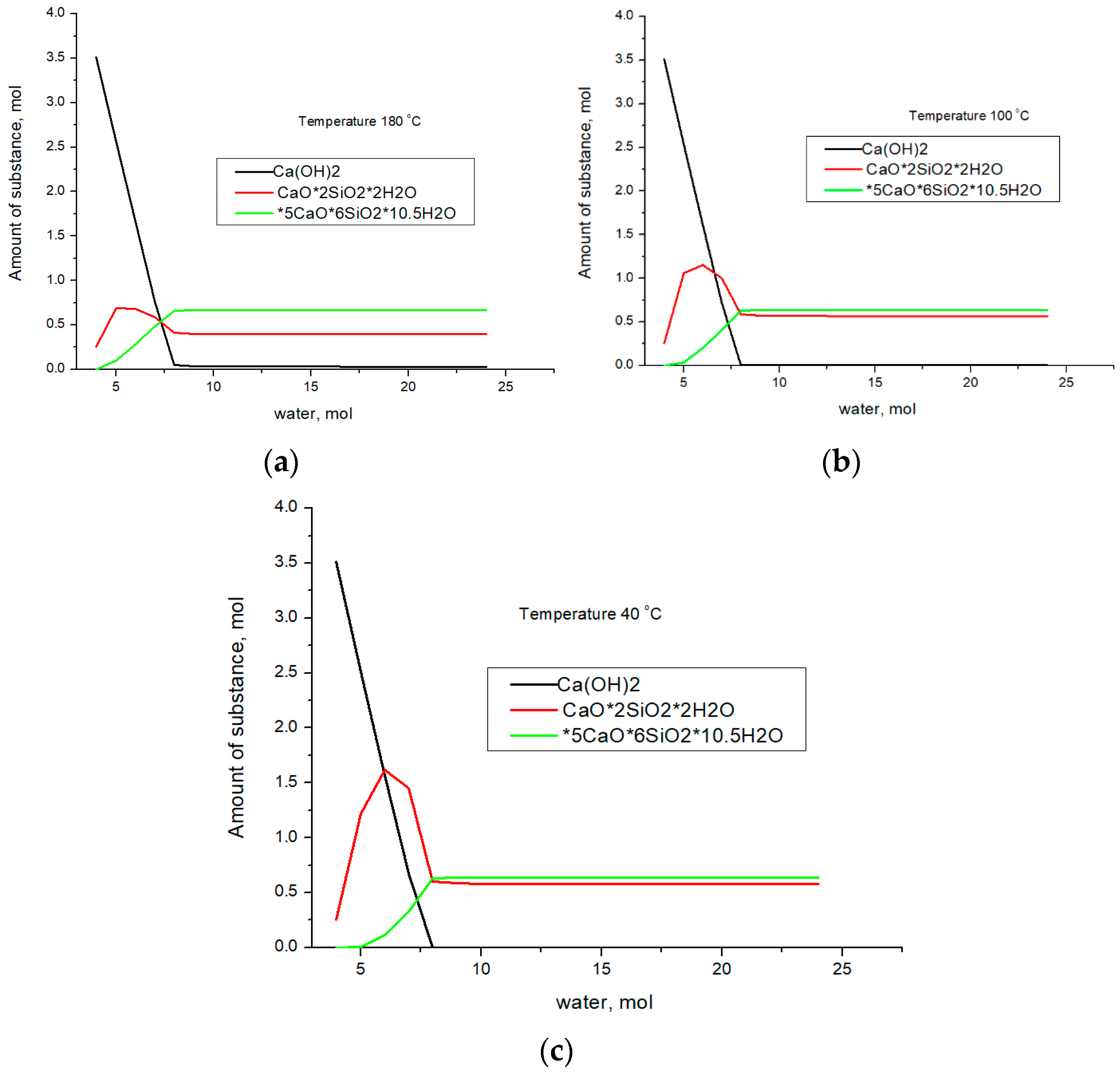
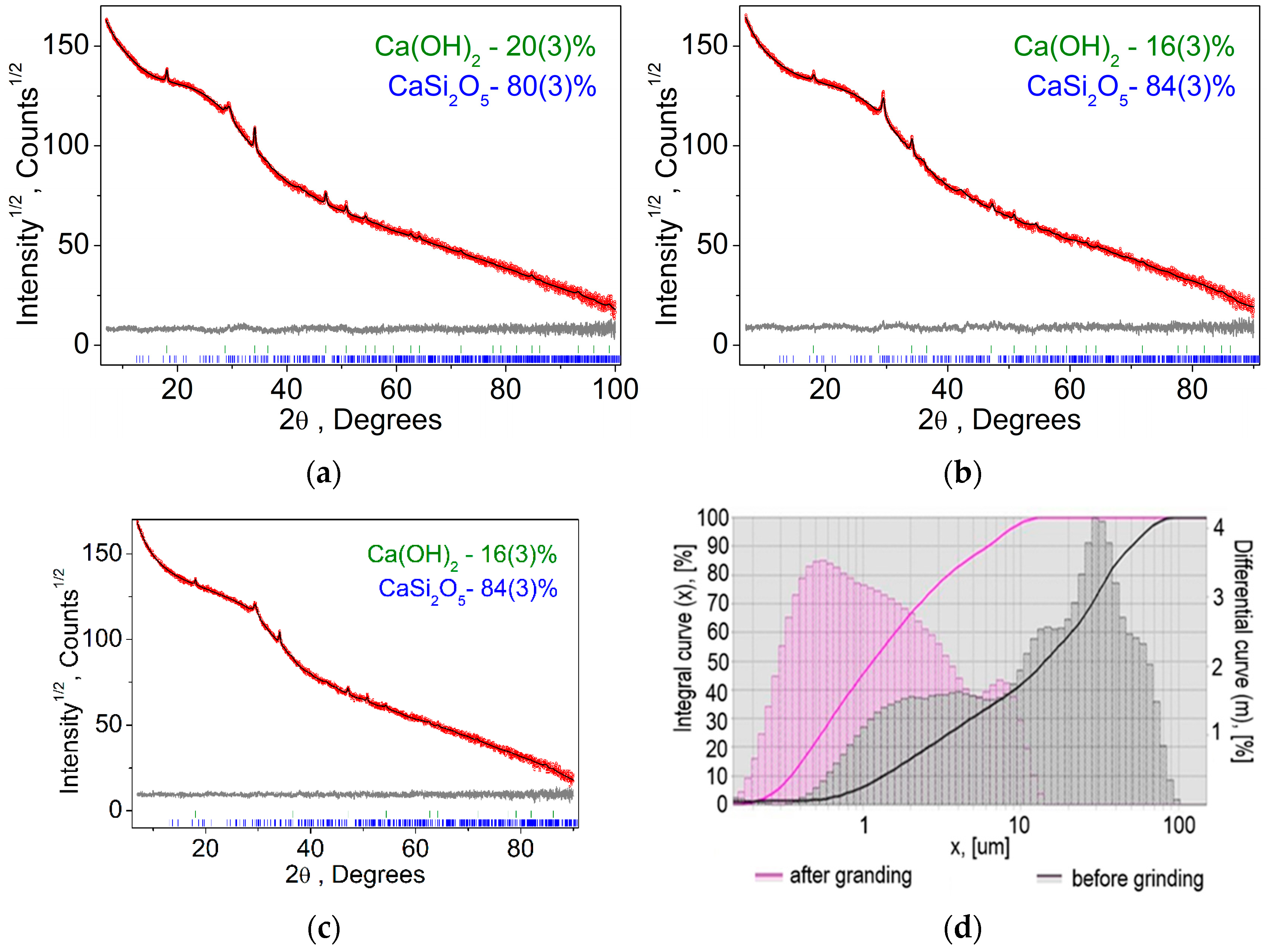
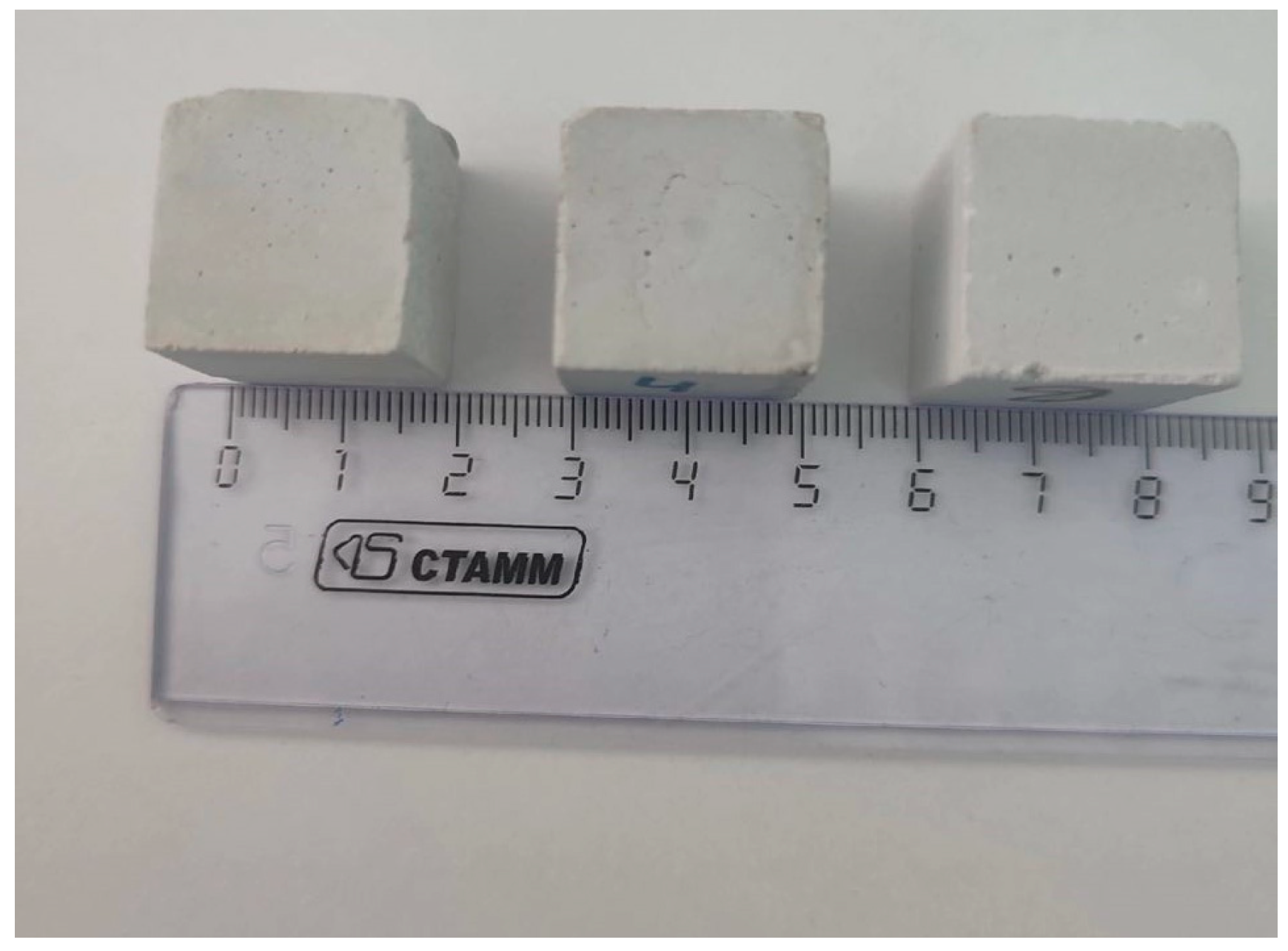

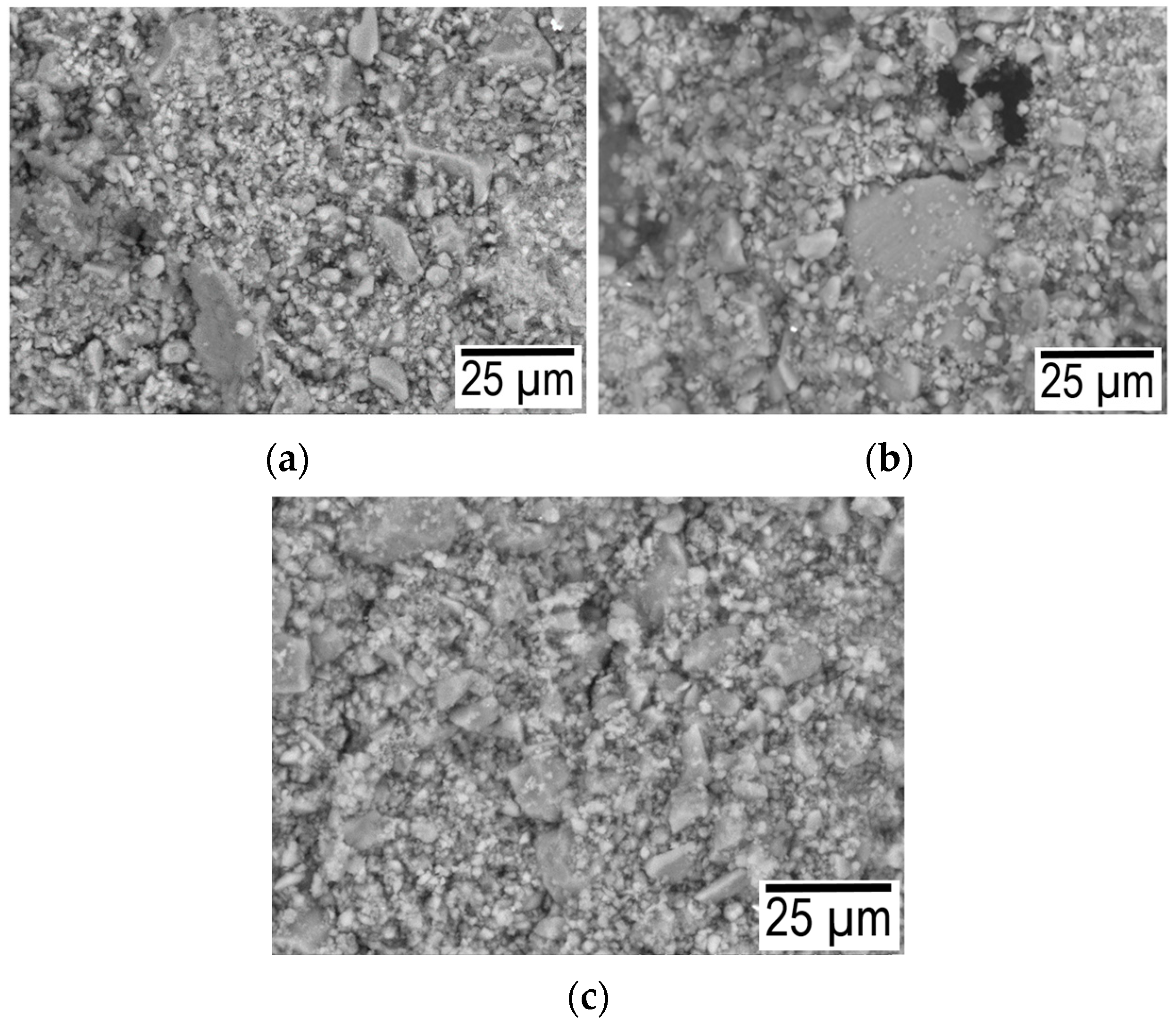
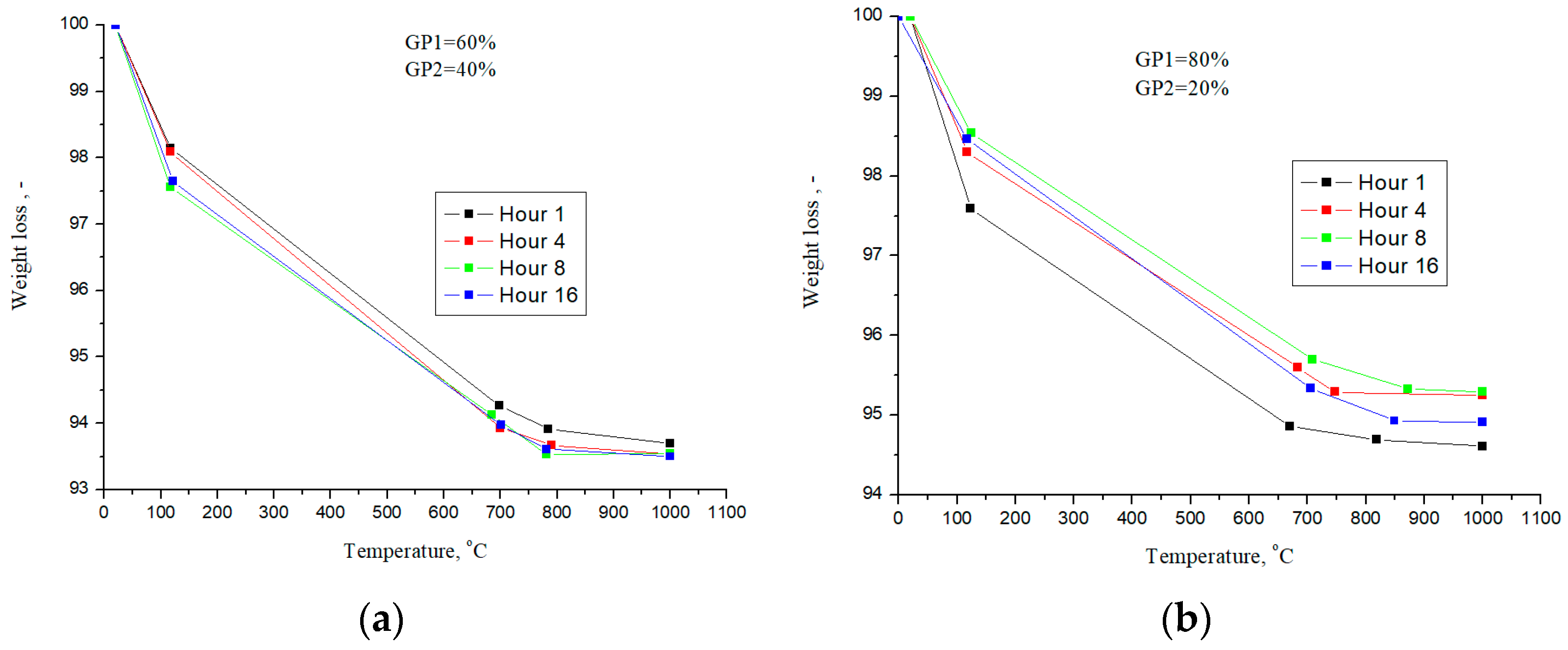
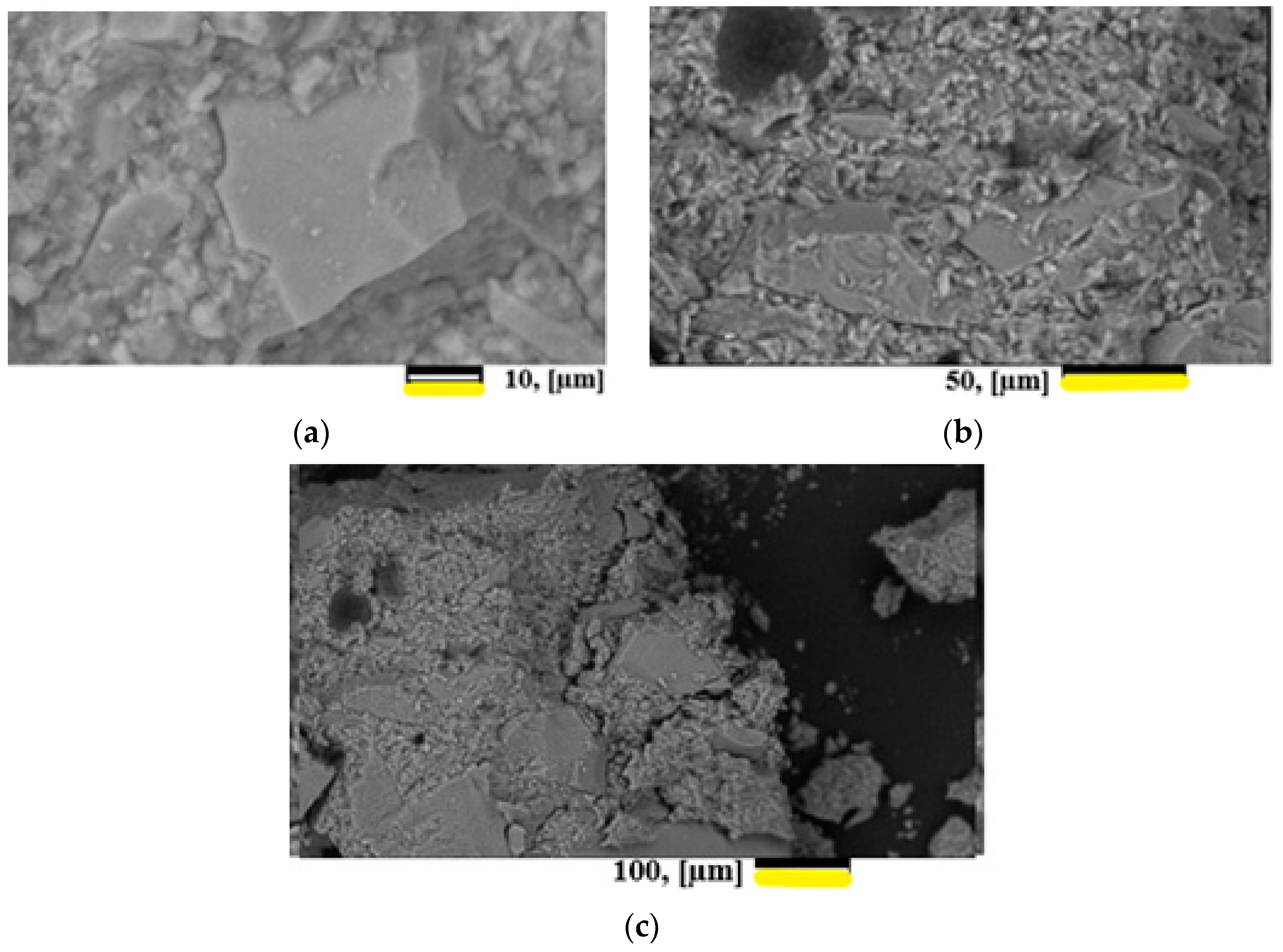
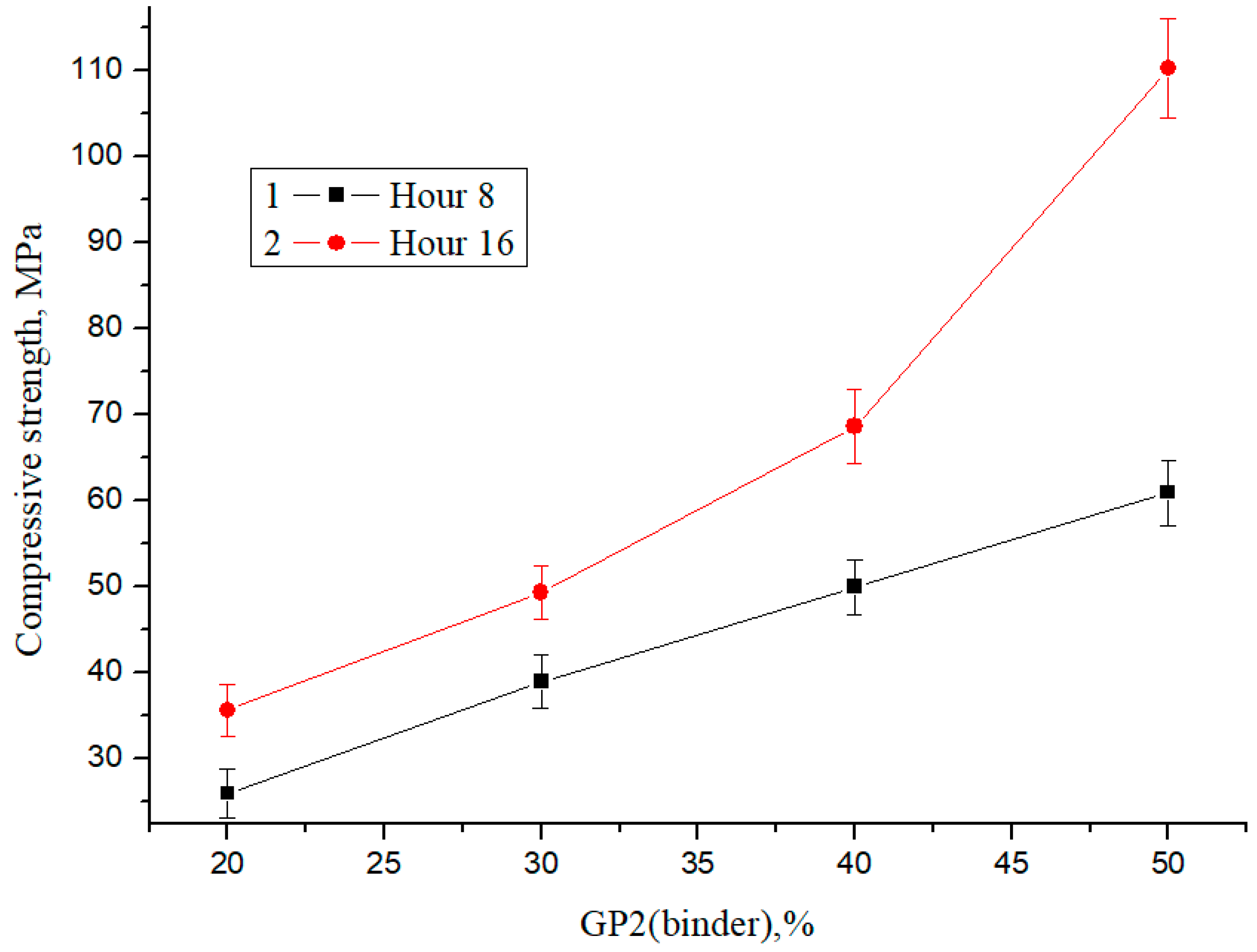
| № | Denotation | Characterization |
|---|---|---|
| 1 | RETSCH PM 400 MA(Germany) planetary ball mill. | Specifications: 4 grinding jars with a nominal volume of 500 mL. The free speed setting from 30 to 400 rpm in combination with an effective 300 mm diameter planetary disk produces a particularly high transmitted energy. Speed ratio −1:−3. Ability to calculate the total energy transferred to the material during the grinding process. |
| 2 | FRITSCH ANALYSETTE 22 MicroTec PLUS(Germany) laser particle size analyzer | Measurement duration 5–10 s (registration of measurement results of one individual measurement), 2 min (full measurement cycle). Adjustable centrifugal pump with a maximum flow of 5.5 L/min. |
| 3 | Hitachi TM 4000 microscope (Japan) equipped with a BruckerXFlash 430 (Germany) X-ray microanalysis attachment | Zoom ×10–×100,000; Accelerating voltage: 5 kV, 10 kV, 15 kV; Table movement: X ± 40 mm, Y ± 35 mm; Maximum sample size: 80 mm in diameter, 50 mm in height; Minimum travel step: 65 nm; Detectors: 4-segment highly sensitive semiconductor detector, secondary electron detector for low vacuum mode; Electron source: pre-centered tungsten cathode; Country of origin: Japan. |
| 4 | Haoyuan DX-2700BH(China) powder diffractometer (analytical equipment of Krasnoyarsk Regional Center of Research Equipment of Federal Research Center “Krasnoyarsk Science Center SB RAS”) | Cu-Kα radiation and linear detector. The step size of 2θ was 0.01°, and the counting time was 0.2 s per step. Therefore, these structures were taken as starting model for Rietveld refinement which was performed using TOPAS 4.2 |
| 5 | Netzsch TG-DSK STA 409 PC Jupiter (Germany). | Sensitivity: 0.002 mg; operating temperature range: 25–1500 °C; rate of temperature change: 0.1–50 °C/min; the ability to work in neutral and oxidizing gas environments. |
| 6 | Instron 3360(USA) Series Testing Press (5 tons), for physico-mechanical tests. | Manufacturer information: Instron, USA. Purpose: Testing of building materials. Scope: Determination of strength characteristics of materials. Characteristics: Maximum load 5 tons. |
| Glass | Mass Content, % | ||||||
|---|---|---|---|---|---|---|---|
| sheet | SiO2 | Al2O3 | MgO | CaO | Na2O | Fe2O3 | SO3 |
| 70.64 | 0.68 | 3.55 | 9.93 | 13.66 | 0.18 | 0.5 | |
| № | Chemical Formula | S, J/mol·K | , J/mol |
|---|---|---|---|
| 3 | 3CaO×SiO2 | 168.6 | −2929.2 |
| 4 | 2CaO×SiO2×H2O | 171.13 | −3138.84 |
| 5 | Ca(OH)2 | 83.4 | −985.9 |
| 6 | 2CaO×SiO2 | 120.8 | −2315.22 |
| 7 | CaSiO3 | 171.13 | −3138.84 |
| 8 | SiO2 | 41.46 | −910.86 |
| 9 | 2CaO×SiO2×1.167H2O | 160.67 | −2665.21 |
| 10 | 2CaO×3SiO2×2.5H2O | 271.54 | −4920.38 |
| 11 | 3CaO×2SiO2×3H2O | 312.13 | −4782.31 |
| 12 | 4CaO×3SiO2×1.5H2O | 330.33 | −6020.78 |
| 13 | 5CaO×6SiO2×3H2O | 513.17 | −9935.74 |
| 14 | 5CaO×6SiO2×5.5H2O | 611.49 | −10,686.77 |
| 15 | 5CaO×6SiO2×10.5H2O | 808.14 | −12,179.6 |
| 16 | 6CaO×6SiO2×H2O | 507.52 | −10,024.86 |
| 17 | CaO×2SiO2×2H2O | 171.13 | −3138.84 |
| Synthesis Temperature | 40 °C | 100 °C | 180 °C | |||
|---|---|---|---|---|---|---|
| Phase | Ca(OH)2 | CaSi2O5 | Ca(OH)2 | CaSi2O5 | Ca(OH)2 | CaSi2O5 |
| Weight, % | 20(3) | 80(3) | 16(3) | 84(3) | 16(3) | 84(3) |
| Sp. Gr. | Pm-31 | P-1 | Pm-31 | P-1 | Pm-31 | P-1 |
| a (Å) | 3.5907(16) | 7.17(1) | 3.587(4) | 7.26(1) | 3.593(2) | 7.49(1) |
| b (Å) | 3.5907(16) | 7.67(1) | 3.587(4) | 7.64(1) | 3.593(2) | 7.45(1) |
| c (Å) | 4.917(3) | 6.573(9) | 4.884(6) | 6.538(9) | 4.913(4) | 6.52(1) |
| α (°) | 90 | 82.1(1) | 90 | 81.95(7) | 90 | 82.1(1) |
| β (°) | 90 | 85.4(1) | 90 | 85.25(7) | 90 | 84.6(1) |
| γ (°) | 120 | 68.7(1) | 120 | 69.04(6) | 120 | 70.1(1) |
| V (Å3) | 54.90 (6) | 333.5(9) | 54.4(1) | 335.1(9) | 54.94(9) | 338.4(9) |
| RB, % | 0.77 | 0.81 | 0.98 | 0.99 | 0.45 | 0.36 |
| 2θ-interval, ° | 10–100 | 10–90 | 10–90 | |||
| Rwp, % | 2.39 | 2.45 | 2.10 | |||
| Rp, % | 1.49 | 1.56 | 1.25 | |||
Disclaimer/Publisher’s Note: The statements, opinions and data contained in all publications are solely those of the individual author(s) and contributor(s) and not of MDPI and/or the editor(s). MDPI and/or the editor(s) disclaim responsibility for any injury to people or property resulting from any ideas, methods, instructions or products referred to in the content. |
© 2023 by the authors. Licensee MDPI, Basel, Switzerland. This article is an open access article distributed under the terms and conditions of the Creative Commons Attribution (CC BY) license (https://creativecommons.org/licenses/by/4.0/).
Share and Cite
Dobrosmyslov, S.S.; Zadov, V.E.; Nazirov, R.A.; Shakirova, V.A.; Voronin, A.S.; Simunin, M.M.; Fadeev, Y.V.; Molokeev, M.S.; Shabanova, K.A.; Khartov, S.V. High-Strength Building Material Based on a Glass Concrete Binder Obtained by Mechanical Activation. Buildings 2023, 13, 1992. https://doi.org/10.3390/buildings13081992
Dobrosmyslov SS, Zadov VE, Nazirov RA, Shakirova VA, Voronin AS, Simunin MM, Fadeev YV, Molokeev MS, Shabanova KA, Khartov SV. High-Strength Building Material Based on a Glass Concrete Binder Obtained by Mechanical Activation. Buildings. 2023; 13(8):1992. https://doi.org/10.3390/buildings13081992
Chicago/Turabian StyleDobrosmyslov, Sergey S., Vladimir E. Zadov, Rashit A. Nazirov, Veronika A. Shakirova, Anton S. Voronin, Michail M. Simunin, Yuri V. Fadeev, Maxim S. Molokeev, Ksenia A. Shabanova, and Stanislav V. Khartov. 2023. "High-Strength Building Material Based on a Glass Concrete Binder Obtained by Mechanical Activation" Buildings 13, no. 8: 1992. https://doi.org/10.3390/buildings13081992
APA StyleDobrosmyslov, S. S., Zadov, V. E., Nazirov, R. A., Shakirova, V. A., Voronin, A. S., Simunin, M. M., Fadeev, Y. V., Molokeev, M. S., Shabanova, K. A., & Khartov, S. V. (2023). High-Strength Building Material Based on a Glass Concrete Binder Obtained by Mechanical Activation. Buildings, 13(8), 1992. https://doi.org/10.3390/buildings13081992





